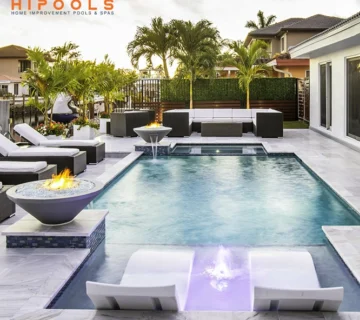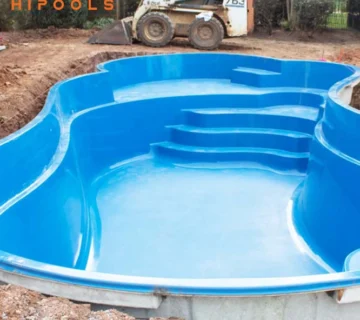The joy derived from a newly installed pool is paramount, however, it’s longevity alongside its luster hinges upon regular maintenance. Proper upkeep wards off expensive repairs, algae growth, and cloudy water. It doesn’t matter if you are a novice pool owner or looking to update your regimen, this manual offers steps and skills for daily, weekly and seasonal actions to ensure that your pool remains pristine and enticing.
1. Daily & Weekly Maintenance Tasks: Protect Your Investment with Simple Routines
Consistent care is the key to preserving your pool’s sparkle, safety, and equipment lifespan. By dedicating just 10, 15 minutes daily and an hour weekly, you’ll prevent algae outbreaks, equipment strain, and costly repairs. Here’s how to master new pool care with easy yet effective tasks:
Skim and Scrub: Your First Line of Defense
Daily Skimming
Use a handheld net or automatic skimmer to remove leaves, insects, and debris floating on the surface. This prevents:
- Clogged Filters: Debris can block skimmer baskets and reduce water flow.
- Stained Surfaces: Organic matter like pollen can sink and stain pool floors.
- Algae Food: Rotting leaves release phosphates, fueling algae growth.
Note Tip: Skim in the morning and evening for best results, especially during fall or windy days.
Weekly Brushing
Brush walls, steps, and floors with a nylon bristle brush (concrete pools) or soft brush (vinyl/fiberglass). Focus on corners and behind ladders where algae hides.
- Prevents Algae: Disturbs biofilm before it takes hold.
- Enhances Circulation: Loosens debris for the filter to capture.
Note Tip: Pair brushing with a robotic cleaner for hands off efficiency.

Check the Filter: Keep Water Crystal Clear
Your filter is the pool’s “kidneys” neglect leads to cloudy water and pump damage.
Daily Skimmer Basket Cleaning
- Empty skimmer and pump baskets daily to maintain water flow.
- Why It Matters: Clogged baskets strain the pump motor, risking $200+ repairs.
Weekly Backwashing (Sand Filters)
- Turn off the pump, set the valve to “backwash,” and run until the sight glass clears (2, 3 minutes).
- Frequency: Weekly or when the pressure gauge rises 8, 10 psi above normal.
Pro Tip: For cartridge filters, rinse with a hose monthly and replace every 2, 3 years.
Monitor Water Levels: Balance and Safety
Pool Water Level
Keep water halfway up the skimmer opening. Too low? The pump can run dry and burn out. Too high? Skimmers can’t capture debris.
- Fix It: Use a garden hose to refill or a submersible pump to drain excess.
Chlorine Levels
Test chlorine daily with strips or a kit. Ideal range: 1, 3 ppm.
- Low Chlorine: Add liquid chlorine or tablets to prevent bacteria/algae.
- High Chlorine: Can bleach liners and irritate skin neutralize with a chlorine reducer.
Note Tip: Test after heavy rain, parties, or UV heavy days (chlorine degrades in sunlight).
Why Consistency Matters
- Cost Savings: Avoiding algae treatments saves $100, $300 per outbreak.
- Equipment Longevity: Clean filters and proper water levels extend pump life by 5+ years.
- Swimmer Safety: Balanced chlorine and pH prevent rashes, red eyes, and infections.
Sample Weekly Schedule
| Day | Task |
|---|---|
| Daily | Skim debris, check chlorine. |
| Monday | Brush walls/floors. |
| Friday | Backwash filter, test full chemistry. |
Up next: Dive into pool water balance to fine tune your chemistry for flawless results!
2. Balancing Pool Water Chemistry: The Science Behind Sparkling, Safe Swimming
Proper pool water balance is the unsung hero of pool maintenance. Even with flawless filtration and cleaning, imbalanced chemistry leads to murky water, irritated skin, and costly equipment damage. This guide breaks down the four pillars of water chemistry pH, alkalinity, calcium hardness, and chlorine and how to keep them in harmony for a pristine, safe pool.
Why Water Chemistry Matters
- Swimmer Comfort: Balanced water prevents red eyes, dry skin, and itchy scalps.
- Equipment Protection: Corrosion or scaling from imbalanced chemistry can destroy pumps, heaters, and liners.
- Algae Prevention: Proper chlorine and pH levels stop algae before it starts.
Test weekly with a test kit ($20, $50) or test strips ($10, $20). For accuracy, collect water 18 inches below the surface and away from jets.
The 4 Key Parameters (and How to Fix Imbalances)
| Parameter | Ideal Range | Too Low | Too High | How to Adjust |
|---|---|---|---|---|
| pH | 7.4-7.6 | Acidic Water: Corrodes metal, irritates skin. | Basic Water: Cloudy water, scale buildup. | Low: Add soda ash. High: Use muriatic acid. |
| Total Alkalinity | 80-120 ppm | pH swings wildly. | pH resists adjustment, cloudy water. | Low: Add baking soda. High: Use pH reducer. |
| Calcium Hardness | 200-400 ppm | Erodes plaster, damages surfaces. | Scaling on tiles and equipment. | Low: Add calcium chloride. High: Partially drain and refill. |
| Chlorine | 1-3 ppm | Bacteria/algae thrive. | Bleaches liners, harsh on skin. | Low: Add tablets/liquid. High: Neutralize with sodium thiosulfate. |
Pro Tips for Effortless Balance
- Test After Heavy Use: Parties or rain dilute chlorine and alter pH.
- Stabilize Chlorine: Add cyanuric acid (30, 50 ppm) to shield chlorine from UV rays.
Seasonal Adjustments:
- Summer: Higher chlorine demand (2, 4 ppm) due to heat/UV.
- Winter: Lower chlorine (1, 2 ppm) if covered.

Common Mistakes to Avoid
- Ignoring Alkalinity: It’s the “buffer” for pH low alkalinity causes pH rollercoasters.
- Mixing Chemicals: Adding chlorine and acid simultaneously can create toxic fumes.
- Over Stabilizing: Excess cyanuric acid (>100 ppm) renders chlorine ineffective.
Cost of Neglect: A Real-World Example
A Georgia homeowner ignored high pH (8.2) for months, leading to:
- $500 in corroded ladder and pump parts.
- $300 in scaling removal from tiles.
- $200 in algaecide to treat an outbreak.
Regular testing (10 minutes/week) could’ve prevented $1,000+ in repairs.
Key Takeaway: Balanced water isn’t optional it’s the foundation of new pool care. Pair these pool cleaning tips with weekly testing, and your pool will reward you with years of trouble free enjoyment.
Click here for more information about How to Clean a Pool and Keep the Water Safe.
3. Monthly Deep Clean Routines: Preserve Your Pool’s Pristine Condition
While daily skimming and weekly brushing keep your pool looking clean, monthly deep cleaning tackles hidden grime, equipment wear, and water contaminants. Dedicate one weekend a month to these tasks, and you’ll avoid costly repairs and keep your pool safe for swimmers.
1. Vacuum the Pool: Banish Settled Debris
Even with a top-notch filter, dirt and sand settle on the pool floor. Vacuuming removes these particles before they stain surfaces or clog equipment.
Choosing the Right Vacuum
| Type | Best For | Cost | Pros/Cons |
|---|---|---|---|
| Manual Vacuum | Small pools, precise cleaning. | $50–$150 | Affordable, but labor-intensive. |
| Automatic Robotic | Hands-free cleaning, large pools. | $600–$1,500 | Saves time, but pricey. |
| Suction-Side | Budget-friendly automation. | $200–$500 | Connects to skimmer, slower than robotic. |
Steps to Vacuum:
- Attach the vacuum head to a telescopic pole and hose.
- Prime the hose by submerging it to remove air bubbles.
- Set the filter to “waste” (for manual vacuums) to bypass debris through the waste line.
- Move the vacuum slowly across the floor, overlapping strokes.
2. Inspect Equipment: Catch Issues Early
Monthly inspections prevent minor issues from becoming major repairs. Focus on:
Pump and Motor
- Leaks: Check for water around seals or connections. Replace O-rings if cracked.
- Strange Noises: Grinding or screeching signals bearing wear (cost: $150, $400 to replace).
Heater
- Corrosion: Look for rust on burners or heat exchangers.
- Blockages: Clear leaves or debris from intake vents.
Filter
- Pressure Gauge: A reading 10+ psi above normal indicates clogs.
- Sand Filters: Inspect sand for channeling (uneven wear) and replace every 5 ,7 years.
3. Shock the Pool: Reset Water Purity
“Shocking” means adding 3, 5x the normal chlorine dose (5, 10 ppm) to destroy contaminants like sweat, sunscreen, and bacteria.
When to Shock:
- Monthly: Prevents algae and keeps water sparkling.
- After Heavy Use: Parties or storms introduce organic waste.
- Algae Outbreaks: Turns water from green to clear in hours.
Steps:
- Test chlorine levels ensure they’re below 5 ppm.
- Add granular shock (calcium hypochlorite) at dusk to prevent UV degradation.
- Run the pump for 8, 12 hours to circulate.
Cost: $10–$20 per treatment vs. $200+ for algae removal.
4. Seasonal Maintenance Tips: Adapt to Georgia’s Climate
Georgia’s hot summers and mild winters require tailored care. Follow these seasonal pool cleaning tips to protect your investment year-round.
Spring/Summer: Combat Heat and Heavy Use
Algae Prevention:
- Brush Walls Weekly: Focus on shaded areas where algae thrive.
- Use Algaecide: Polyquat 60 (non foaming) is ideal for weekly maintenance ($20, $30/bottle).
- Maintain Chlorine: Heat and UV rays degrade chlorine faster test daily.
Optimize Filtration:
- Run Pumps 8,12 Hours Daily: Split cycles (…, 4 AM, 8 AM and 4 PM, 8 PM) to save energy.
- Clean Filters Monthly: Summer pollen and dust clog filters faster.
Pro Tip: Install a solar cover to reduce evaporation and keep water warm overnight.
Fall/Winter: Prepare for Cold Snaps
Winterizing Pools:
- Balance Chemistry: Adjust pH (7.4, 7.6), alkalinity (80, 120 ppm), and chlorine (3, 5 ppm).
- Lower Water Level: Drain 4, 6 inches below the skimmer to prevent freezing damage.
- Add Antifreeze: Pour pool-safe antifreeze ($15, $25/gallon) into plumbing lines.
- Secure the Cover: Use a solid or mesh safety cover anchored with weights or springs.
Drain Equipment:
- Blow Out Pipes: Use an air compressor to clear water from lines.
- Store Pumps/Heatrs: Keep in a dry, frost free location.
Cost of Neglect: Frozen pipes can crack, leading to $1,000+ in repairs.
Monthly & Seasonal Checklist
| Task | Monthly | Spring/Summer | Fall/Winter |
|---|---|---|---|
| Vacuum Pool | ✅ | ✅ | ❌ |
| Shock Treatment | ✅ | ✅ (Biweekly) | ❌ |
| Inspect Equipment | ✅ | ✅ | ✅ (Pre-winter) |
| Algaecide Application | ❌ | ✅ | ❌ |
| Winterizing | ❌ | ❌ | ✅ |
Key Takeaway: Consistency is your pool’s best friend. Monthly deep cleans and seasonal tweaks ensure your new pool care routine pays off with fewer repairs, clearer water, and years of enjoyment. Pair this with our pool maintenance guide for a foolproof strategy!

5. Cost Saving Pool Cleaning Tips: Maximize Efficiency, Minimize Expenses
Maintaining a pristine pool doesn’t have to break the bank. By adopting smart strategies and budget-friendly tools, you can slash annual costs by 30, 50% while extending your pool’s lifespan. Here’s how:
Solar Covers: Lock in Heat and Water
- How They Work: These UV-resistant blankets float on the water’s surface, reducing evaporation by 70% and retaining heat.
- Savings: Cut heating costs by 50% and water refill needs by 30, 50% ideal for Georgia’s hot summers.
- Cost: $100, $300 for a durable cover vs. $500+/year in wasted heat/water.
- Pro Tip: Use a solar reel ($150, $300) for easy removal and storage.
Timers: Automate Energy Use
- Off Peak Savings: Run pumps during non-peak hours (…, 8 PM, 6 AM) when Georgia Power’s rates drop. Save $20, $50/month on energy bills.
- Smart Timers: Devices like the Intermatic T104 ($50, $80) automate filtration schedules, ensuring 8, 12 hours of daily runtime without manual effort.
DIY Testing: Skip the Pros, Save $100+/Year
- Test Kits vs. Strips: A Taylor K-2006 kit ($75) offers lab-grade accuracy for pH, alkalinity, and chlorine. Strips ($15) are quick but less precise.
- Cost Comparison: Professional testing costs $15, $25/month vs. a $20 kit lasting 6+ months.
- Pro Tip: Test weekly and after storms or heavy use to maintain balance.
6. Common Mistakes to Avoid: Dodge Costly Pitfalls
Even seasoned pool owners make errors. Here’s how to sidestep the top three budget-busters:

Ignoring pH Imbalance
- Risks:
- Low pH (<7.2): Corrodes metal parts (ladders, heaters) and irritates skin/eyes.
- High pH (>7.8): Causes scaling on tiles and cloudy water.
- Fix: Test weekly. Adjust with muriatic acid (lower pH) or soda ash (raise pH).
Overlooking Filter Maintenance
- Consequences: Clogged filters strain pumps, spiking energy bills by 20% and risking motor burnout ($200–$500 repair).
- Prevent It:
- Sand Filters: Backwash weekly.
- Cartridge Filters: Rinse monthly; replace every 2–3 years.
Skipping Winterization
- Georgia Specific Risks: Even mild winters can freeze pipes, cracking pumps or plumbing ($1,000+ repairs).
- Must-Do Steps:
- Lower water 4-6 inches below the skimmer.
- Blow out pipes with an air compressor.
- Add pool-safe antifreeze ($15, $25/gallon).
Your Pool, Your Paradise Keep It Perfect Year Round
With this pool maintenance guide, you’re equipped to enjoy crystal-clear water while avoiding expensive missteps. From leveraging solar covers to automating pumps and mastering DIY testing, small efforts yield big savings. Remember: Consistency is key—balance chemistry weekly, clean filters monthly, and winterize diligently.
Need Help? The Hipools Team in Georgia is here to simplify your pool care!
Request a Free Consultation Today
📞 Call: (770) 250-8579 | 💻 Visit: www.hipoolss.com
Why wait? Transform pool maintenance from a chore into a breeze effortlessly!
A little effort today saves thousands tomorrow. Dive into hassle free pool ownership!




No comment